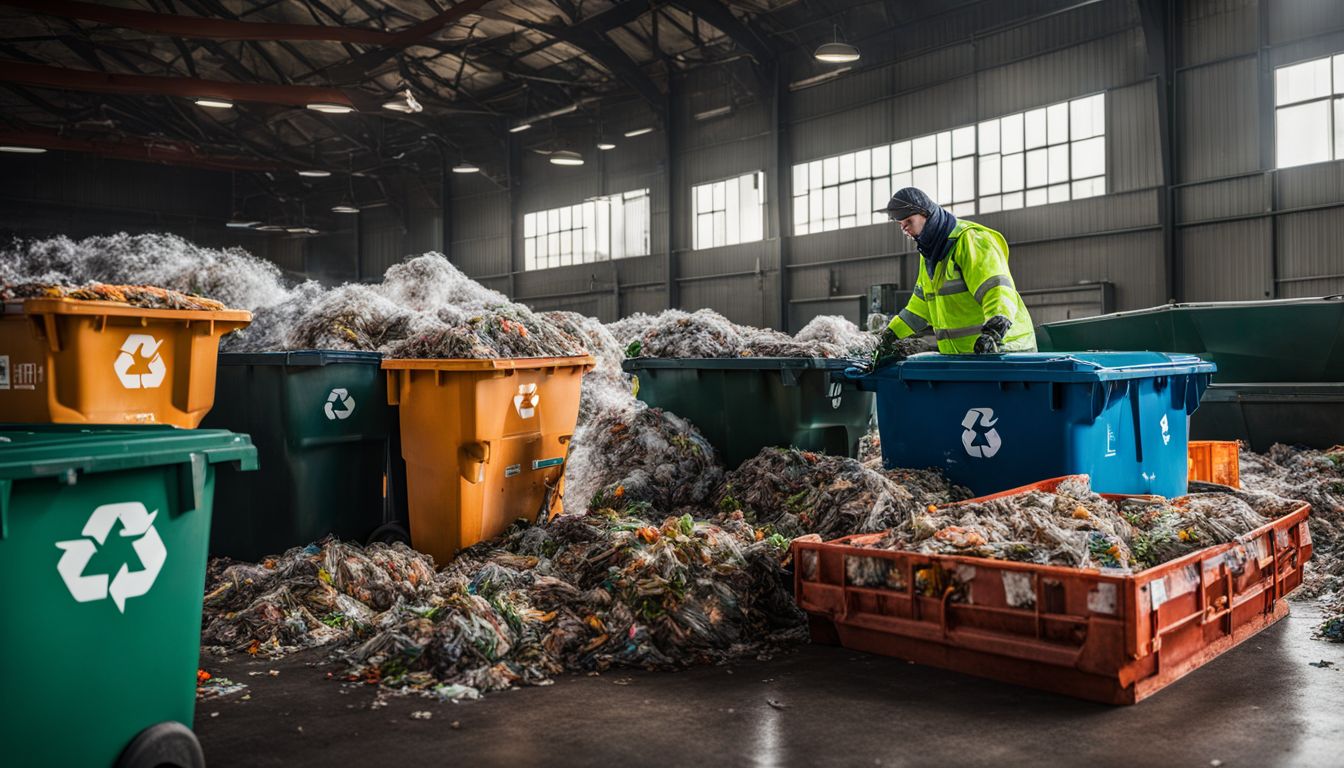Be Amazed: These Cities Earns The Title of World’s Greenest
Our cities are growing at an unprecedented rate, leaving many of us wondering how to balance urban development with environmental sustainability. Did you know that Vienna, Austria has been consistently ranked as the greenest city worldwide? This blog post will walk you through why cities like Vienna have prioritized green initiatives and how they’ve successfully implemented sustainable practices.
Let’s embark on a journey to explore the finest examples of eco-friendly urban living!
Key Takeaways
- Vienna, Austria is consistently ranked as the greenest city in the world due to its sustainable urban planning, extensive green spaces and parks, renewable energy initiatives, and efficient public transportation system.
- Green cities prioritize sustainability and benefit both the environment and residents by promoting clean air and water, reducing pollution levels, and enhancing overall well-being.
- Key criteria for evaluating green cities include the presence of green spaces and parks, utilization of renewable energy sources, efficient public transportation systems, effective waste management practices, and high air and water quality standards.
Why Cities are Going Green

Cities are going green due to the importance of sustainability and the benefits it brings for the environment and residents, as well as global efforts towards a more sustainable future.
Importance of sustainability

Keeping our city green is very important. A green city is clean and healthy. It has good air and water. Green cities use energy that is safe for Earth, not oil or coal. They have many trees and parks where people can enjoy nature.
People in a green city recycle their trash so it doesn’t harm the planet. Being green helps every person live better lives and protects the future too!
Benefits for the environment and residents

Going green helps the earth and the people living on it. Clean air and water from green spaces keep us healthy. Cities that use renewable energy help cut down dirty air. This can stop kids from getting sick with asthma.
Taking care of waste in a smart way also keeps our towns clean. It stops trash from filling up land and water areas. Green cities are nice places to live because they have lots of trees and parks.
Using bikes or buses instead of cars can make you feel better, too! It gets your body moving more often, which is good for your health. Plus, less cars mean less smoke in the air.
All in all, being kinder to the environment leads to happier residents in our city spaces!
Global efforts towards sustainability

All around the world, cities are working hard to be green. They want to help our planet. Vienna, Austria sets the bar high as a top-green city. Copenhagen is not far behind with its bike-friendly streets.
This Danish city also aims to have zero carbon in the air soon. In Berlin, Madrid, Curitiba, Amsterdam and Singapore too, big steps are taken for sustainability. They all focus on having more green spaces and clean energy sources.
They work hard on managing waste better and making travel easier without cars.
Criteria for Evaluating Green Cities

To evaluate green cities, key criteria include the presence of green spaces and parks, utilization of renewable energy sources, efficient public transportation systems, effective waste management practices, and high air and water quality standards.
Green spaces and parks

Green spaces and parks play a crucial role in creating green cities. They contribute to the overall well-being of residents, provide habitats for wildlife, and help improve air quality.
Vienna, Austria, the greenest city in the world, is known for its abundant green spaces and parks. These areas not only offer recreational opportunities but also help combat climate change by absorbing carbon dioxide.
Copenhagen, Denmark, another leading green city, has prioritized the development of parks and open spaces to enhance the quality of life for its residents. Green spaces and parks are essential components of sustainable urban planning that promote eco-conscious living and connect people with nature.
Renewable energy sources

Renewable energy sources are essential for creating sustainable and environmentally friendly cities. These sources, such as solar and wind power, help reduce the reliance on fossil fuels that contribute to climate change.
Cities can harness renewable energy through the installation of solar panels on rooftops or by investing in wind farms. Vienna, Austria, which is ranked as the greenest city in the world, has implemented various initiatives to increase its use of renewable energy.
Copenhagen, Denmark, another top-ranked green city, also focuses on renewable energy targets and has made significant advancements in utilizing wind power. By embracing renewable energy sources, cities can reduce their carbon footprint and create a more sustainable future for all.
Public transportation

Public transportation plays a crucial role in creating greener cities. Cities with efficient public transportation systems help reduce traffic congestion and carbon emissions from cars, leading to cleaner air and a healthier environment.
Vienna, the greenest city in the world, is known for its reliable and well-connected public transportation network. Copenhagen, another top-ranking green city, promotes cycling and walking as primary modes of transport while also offering an extensive metro system.
Amsterdam is famous for its bicycle-friendly infrastructure that encourages residents to bike instead of driving. Efficient and sustainable public transportation options are vital in reducing pollution levels and promoting eco-friendly urban living.
Waste management

Waste management is an important factor in evaluating green cities. Proper waste management helps reduce pollution and keeps the environment clean. Cities like Vienna and Copenhagen prioritize this aspect of sustainability by implementing efficient waste disposal systems.
They strive to minimize waste generation and promote recycling and composting programs to divert waste from landfills. These cities also invest in modern technologies for treating wastewater and reducing water pollution.
By focusing on responsible waste management, green cities contribute to a healthier, more sustainable future for all.
Air and water quality
Air and water quality are crucial factors when evaluating green cities. Clean air is important for the health of residents, while clean water is essential for both human consumption and the environment.
Vienna, the greenest city in the world, has made significant efforts to ensure high air and water quality. The city has implemented strict regulations on emissions from vehicles and industries, leading to reduced pollution levels.
Additionally, Vienna prioritizes clean water by investing in sustainable wastewater treatment systems and preserving its natural water sources. Other top green cities like Amsterdam, Copenhagen, Singapore, and Stockholm also prioritize air and water quality through various initiatives such as promoting renewable energy use, efficient public transportation systems that reduce vehicle emissions, implementing waste management strategies to prevent pollution of water sources, and conserving natural resources.
Vienna, Austria: The Greenest City in the World
Vienna, Austria is widely recognized as the greenest city in the world due to its sustainable urban planning, extensive green spaces and parks, renewable energy initiatives, and efficient public transportation system.
Sustainable urban planning
Sustainable urban planning is an essential aspect of creating environmentally friendly cities. It involves designing and developing cities in ways that prioritize sustainability, minimize environmental impact, and promote the well-being of residents.
This includes considerations such as land use zoning, efficient transportation systems, green spaces and parks, energy-efficient buildings, and waste management strategies. Vienna and Copenhagen are leading examples of cities that have embraced sustainable urban planning.
They have implemented policies to reduce carbon emissions, improve public transportation infrastructure, incorporate renewable energy sources into their city grids, and create green spaces for residents to enjoy.
Green spaces and parks
Green spaces and parks play a vital role in creating sustainable and livable cities. They offer numerous benefits for both the environment and residents. Green areas help improve air quality by absorbing pollutants and provide habitats for wildlife.
They also promote physical activity, mental well-being, and social connections among community members. Vienna, Austria, the greenest city in the world, is known for its extensive network of green spaces and parks that cover almost half of the city’s land area.
Copenhagen, Denmark, another eco-friendly metropolis, prioritizes the integration of green spaces into urban planning to enhance residents’ quality of life. These cities demonstrate how investing in green areas can contribute to creating healthier and more sustainable urban environments.
Renewable energy initiatives
Vienna, Austria and Copenhagen, Denmark are leading the way with their renewable energy initiatives. Vienna has made great strides in this area by implementing sustainable urban planning and investing in renewable energy sources.
The city aims to use 100% green electricity by 2030. Copenhagen, on the other hand, is focused on reaching carbon neutrality by 2025 through renewable energy targets and green building initiatives.
These cities serve as role models for others looking to reduce their dependence on fossil fuels and embrace clean and sustainable energy solutions.
Efficient public transportation system
Vienna, Austria and Copenhagen, Denmark are known for their efficient public transportation systems. In Vienna, the city has an extensive network of trams, buses, and underground trains that make it easy for residents and visitors to get around.
The transportation system is reliable and well-maintained, with frequent services and convenient schedules. Similarly, Copenhagen’s public transportation system is also highly efficient and accessible.
The city has an extensive bike-sharing program and an integrated network of buses and trains that connect different parts of the city. These efficient public transportation systems help reduce traffic congestion, promote sustainability by encouraging people to use alternative modes of transport instead of cars, and contribute to cleaner air quality in these green cities.
Amsterdam in the Netherlands is another city with a notable public transportation system. It has an extensive network of trams, buses, ferries, and trains that provide convenient options for moving around the city.
This comprehensive public transport infrastructure reduces car usage and promotes sustainable mobility.
Singapore boasts one of the most efficient public transportation systems globally as well. The country invests heavily in its Mass Rapid Transit (MRT) system which covers almost every part of Singapore efficiently connecting residential areas with commercial hubs through several lines throughout the country.
Amsterdam, Netherlands: A Model of Sustainability

Amsterdam, Netherlands stands as a model of sustainability with its exceptional bicycling infrastructure, numerous renewable energy projects, and commitment to sustainable buildings and architecture.
Bicycling infrastructure
Many green cities are prioritizing the development of bicycling infrastructure. They are creating dedicated bike lanes and paths, installing bike-sharing systems, and implementing policies to encourage cycling as a mode of transportation.
For example, Copenhagen in Denmark is known for its extensive network of bike-friendly streets and innovative infrastructure that makes it safe and convenient for residents to travel by bicycle.
Amsterdam in the Netherlands is also famous for its cycling culture, with an extensive network of well-maintained bike lanes throughout the city. These initiatives not only reduce traffic congestion but also promote physical activity and help lower carbon emissions from cars.
Renewable energy projects
Vienna, Austria and Copenhagen, Denmark are leading the way in renewable energy projects to make their cities greener. Vienna has implemented various initiatives to promote renewable energy sources like solar power and hydropower.
They have set a goal of generating 100% of their electricity from renewable sources by 2030. Copenhagen is also focused on becoming carbon neutral by increasing their use of wind turbines and investing in district heating systems powered by biomass and geothermal energy.
Both cities have made significant progress in using clean, sustainable energy to reduce their environmental impact and inspire other cities around the world.
Sustainable buildings and architecture
Sustainable buildings and architecture play a crucial role in creating green cities. These cities prioritize eco-friendly construction practices, using materials that are renewable and energy-efficient.
They also focus on reducing carbon emissions by incorporating features like solar panels and efficient insulation. For example, Vienna, Austria has implemented sustainable urban planning strategies that include green buildings with innovative designs.
Amsterdam, Netherlands is also known for its sustainable architecture, with many buildings utilizing renewable energy sources such as wind turbines and solar panels. By prioritizing sustainable buildings, these cities contribute to a more environmentally conscious urban environment for everyone to enjoy.
Amsterdam is an excellent model of sustainability when it comes to its approach to building infrastructure. The city has well-designed cycling infrastructure, making it easier for people to choose bikes over cars for transportation.
Additionally, Amsterdam promotes the use of electric vehicles through charging stations throughout the city and encourages residents to invest in renewable energy projects at home.
The integration of sustainable buildings and architecture not only benefits the environment but also enhances the quality of life for residents by providing healthier living spaces with reduced energy consumption.
Copenhagen is another city leading the way in green living through its commitment to sustainable buildings and architecture. With a strong focus on cycling and walking as primary modes of transportation, Copenhagen has integrated biking lanes into their urban design while implementing renewable energy targets for all new constructions.
The city actively promotes green building initiatives such as using recycled materials and employing advanced insulation techniques to reduce heat loss during colder months.
Waste management strategies
Waste management is an important aspect of creating green cities. Cities around the world are implementing strategies to reduce waste and promote recycling. Vienna, Austria, for example, has a comprehensive waste management system in place.
They have strict regulations on waste separation and provide residents with separate bins for different types of waste. Amsterdam, Netherlands is also known for its effective waste management strategies.
They prioritize recycling and encourage residents to compost their organic waste. Copenhagen, Denmark has implemented innovative solutions such as underground vacuum systems that transport trash directly from homes to collection points.
Copenhagen, Denmark: Leading the Way in Green Living

Copenhagen, Denmark is setting an example for green living with its focus on cycling and walking, renewable energy targets, green building initiatives, and sustainable transportation infrastructure.
Find out how this city is leading the way in creating a more environmentally friendly urban environment. Click here to learn more!
Focus on cycling and walking
Cities that prioritize cycling and walking as modes of transportation are taking important steps towards becoming more environmentally friendly. By encouraging residents to rely less on cars and instead use bikes or walk, these cities reduce carbon emissions and improve air quality.
For example, Copenhagen in Denmark is widely recognized for its bike-friendly streets and commitment to carbon neutrality. With extensive cycling infrastructure and a focus on pedestrian-friendly design, the city has become a model for other urban areas looking to promote sustainable transportation options.
Similarly, Vienna in Austria also emphasizes cycling and walking as part of its sustainable urban planning efforts. These cities show how prioritizing active modes of transportation can contribute to creating greener, healthier, and more livable cities for everyone.
Renewable energy targets
Vienna and Copenhagen, two of the greenest cities in the world, have set ambitious renewable energy targets. Vienna is committed to sourcing 100% of its energy from renewables by 2030.
They have already made significant progress with their renewable energy initiatives which include solar panels on buildings and wind turbines in nearby areas. Copenhagen aims to become carbon neutral by 2025 and has been working towards this goal for many years.
They have invested in wind power, district heating systems, and other renewable sources. These cities are leading the way in implementing clean and sustainable energy solutions, inspiring other cities around the world to follow their example.
Amsterdam is also prioritizing renewable energy as part of its sustainability efforts. The city has a target to generate 50% of its electricity from renewables by 2030. They are investing in solar panels on public buildings, offshore wind farms, and promoting the use of electric vehicles.
Singapore has set a similar target of increasing the share of renewables to at least 33% by 2030. They are focusing on solar power installations on rooftops, floating solar farms, and exploring new technologies like tidal turbines.
Stockholm is another city that aims to be powered entirely by renewable energy sources by 2040. They have been investing in large-scale wind power projects as well as expanding their use of bioenergy sourced from organic waste materials.
These cities understand the importance of transitioning away from fossil fuels and are taking action to reduce their carbon footprint while achieving self-sufficiency with clean energy production.
Green building initiatives
Cities around the world are implementing green building initiatives to promote sustainable urban development. These initiatives focus on constructing buildings that are energy-efficient, use renewable materials, and minimize their carbon footprint.
Green building designs often incorporate features like solar panels for generating clean energy, rainwater harvesting systems, and efficient insulation to reduce energy consumption.
By adopting these measures, cities can significantly decrease their environmental impact while creating healthier and more livable spaces for residents. Vienna and Copenhagen are leading examples of cities that have successfully implemented green building initiatives as part of their overall sustainability strategies.
Sustainable transportation infrastructure
Cities with sustainable transportation infrastructure play a crucial role in becoming green and eco-friendly. These cities prioritize public transportation, cycling, and walking as efficient and environmentally friendly modes of travel.
Vienna, Austria, for example, has an efficient public transportation system that encourages residents to use buses, trams, and trains instead of cars. Copenhagen, Denmark is known for its bike-friendly streets and extensive network of cycling paths.
By investing in sustainable transportation options like these, these cities are reducing carbon emissions and promoting healthier lifestyles for their residents.
The Role of Ecological Planting in Green Cities

Green cities prioritize ecological planting as a crucial aspect of their sustainability efforts. Ecological planting involves the strategic placement of native plants and trees in urban areas to enhance biodiversity, improve air quality, conserve water, and create habitats for wildlife.
By incorporating more green spaces and vegetation into city landscapes, these cities not only beautify their surroundings but also mitigate the effects of climate change.
Ecological planting plays a significant role in improving urban ecosystems by reducing pollution levels. Trees and plants help filter harmful gases from the air while absorbing carbon dioxide during photosynthesis.
This process helps to counteract greenhouse gas emissions and combat global warming. Additionally, green spaces act as natural cooling systems by providing shade and decreasing the urban heat island effect.
Incorporating native plant species into ecological planting initiatives is essential for supporting local wildlife populations. These plants provide food sources and shelter for birds, insects, bees, butterflies, and other animals that are vital to maintaining a healthy ecosystem balance within cities.
Moreover, diverse vegetation promotes healthier soil conditions by preventing erosion and replenishing nutrients.
Cities around the world recognize the importance of ecological planting as an integral part of their environmental strategies. Combining sustainable urban planning with ecologically-minded landscaping creates vibrant green corridors throughout metropolises like Vienna, Copenhagen, Amsterdam, Singapore, Stockholm, Berlin Madrid Curitiba among others.
By prioritizing ecological planting practices on streetscapes,parks,and rooftops across these cities , they set an example inspiring other urban areas worldwide to follow suit in creating greener environments that benefit both residents another flora fauna.species..
Singapore: The Garden City

Singapore stands out as a shining example of urban greening and biodiversity, with efficient public transportation, water conservation efforts, and sustainable waste management. Discover how this garden city is leading the way in creating a sustainable and livable environment.
Read more to find out!
Urban greening and biodiversity
Urban greening and biodiversity play a crucial role in creating sustainable and eco-friendly cities. By incorporating green spaces such as parks, gardens, and urban forests into the cityscape, these areas provide essential habitats for plants and animals.
They also help improve air quality, reduce noise pollution, and mitigate the heat island effect. Planting trees not only enhances the aesthetics of the city but also supports wildlife by providing nesting sites and food sources.
Furthermore, promoting biodiversity in cities strengthens ecosystems and contributes to overall environmental balance. Cities like Singapore prioritize urban greening initiatives to create a healthier environment for residents while promoting biodiversity conservation efforts.
Efficient public transportation system
Vienna, Austria and Singapore are two cities that stand out for their efficient public transportation systems. In Vienna, the tram network is extensive and connects different parts of the city.
The buses and subways also provide reliable and affordable transportation options for residents. Similarly, in Singapore, the Mass Rapid Transit (MRT) system offers a convenient way to get around the city quickly and efficiently.
Both cities prioritize sustainable modes of transportation, which not only reduce traffic congestion but also lower carbon emissions. These efforts contribute to making Vienna and Singapore greener and more livable cities for everyone.
Water conservation efforts
Water conservation is an important aspect of creating green cities. Cities around the world are implementing various initiatives to conserve water and reduce wastage. Vienna, the greenest city in the world, has made significant efforts to manage its water resources sustainably.
They have implemented efficient irrigation systems in parks and gardens, installed rainwater harvesting systems in buildings, and encouraged residents to use water-saving fixtures like low-flow toilets and faucets.
Similarly, Amsterdam has invested in innovative wastewater treatment technologies to ensure clean water for its residents. Copenhagen has also adopted measures like using recycled water for certain activities and promoting public awareness about responsible water usage.
Sustainable waste management
Sustainable waste management is an important aspect of creating green cities. It involves finding ways to reduce, reuse, and recycle our waste to minimize its impact on the environment.
Cities like Vienna and Copenhagen have made significant strides in this area by implementing innovative waste management systems. For example, Vienna has achieved a recycling rate of over 70%, making it one of the most successful cities in terms of waste diversion from landfills.
Copenhagen, on the other hand, focuses on incinerating waste to generate heat and electricity for the city. These initiatives not only help reduce greenhouse gas emissions but also contribute to resource conservation and a cleaner environment for residents.
Stockholm, Sweden: A Sustainable and Livable City

Stockholm, Sweden stands out as a sustainable and livable city due to its eco-friendly transportation options, district heating and renewable energy initiatives, abundance of green spaces and parks, as well as efficient waste management systems.
Eco-friendly transportation options
Vienna and Copenhagen, the greenest cities in the world, prioritize sustainable transportation options to reduce carbon emissions. Vienna has an efficient public transportation system that includes buses, trams, and trains powered by renewable energy sources.
Meanwhile, Copenhagen is famous for its bike-friendly streets and extensive cycling infrastructure. These cities encourage their residents to use eco-friendly modes of transport like walking, biking, and taking public transit instead of relying on cars.
By promoting these alternatives, they help reduce air pollution and promote a healthier environment for everyone.
District heating and renewable energy
District heating and renewable energy play a vital role in creating sustainable and eco-friendly cities. District heating is an efficient system that provides heat to multiple buildings from a central source, reducing the reliance on individual heating systems.
Cities like Stockholm, Sweden have implemented district heating networks that use renewable energy sources such as biomass and waste heat from industries to reduce carbon emissions.
This not only helps in combating climate change but also reduces air pollution and improves the overall air quality of the city. By prioritizing district heating and embracing renewable energy, cities can significantly contribute towards creating a greener future for all.
Green spaces and parks
Green spaces and parks play a crucial role in making cities greener and more sustainable. They provide places for people to relax, exercise, and connect with nature. Green spaces also help improve air quality by absorbing pollutants and providing oxygen.
Vienna, Austria is known for its abundant green spaces, including parks like Prater Park and Schönbrunn Palace Gardens. Copenhagen, Denmark is also recognized for its commitment to creating green areas within the city, such as King’s Garden and Ørstedsparken.
These cities prioritize the development of green spaces to create healthier and more vibrant urban environments for their residents to enjoy.
Waste management systems
Waste management is an important aspect of green cities. Cities that prioritize sustainability have effective systems in place to manage waste and reduce its impact on the environment.
Vienna, Austria, for example, has implemented innovative waste management practices that ensure proper disposal and recycling. Copenhagen, Denmark also excels in this area with its comprehensive waste management strategies.
These cities understand the importance of reducing waste and minimizing their carbon footprint. By implementing efficient waste management systems, they contribute to a cleaner and healthier environment for everyone.
Curitiba, Brazil: A Green City in an Urban Jungle

Curitiba, Brazil stands out as a green city in the midst of an urban jungle with its innovative public transportation system, recycling and waste management programs, sustainable urban planning, and abundance of green spaces and parks.
Innovative public transportation system
Vienna, Austria and Copenhagen, Denmark are two cities leading the way in innovative public transportation. Vienna has a highly efficient tram and subway system that reduces the need for cars.
The city also offers affordable annual transit passes to encourage people to use public transportation. In Copenhagen, cycling is a huge part of daily life, with dedicated lanes and bike-sharing programs available throughout the city.
Both cities prioritize sustainable transportation as an essential part of their green initiatives, making it easier for residents and visitors to get around without relying on private vehicles.
Recycling and waste management programs
Cities that are committed to becoming greener prioritize recycling and waste management programs. These initiatives play a crucial role in reducing the amount of waste that goes into landfills, conserving resources, and minimizing pollution.
For example, Vienna and Copenhagen, two of the greenest cities in the world, have implemented innovative strategies to promote recycling and proper waste disposal. They have established comprehensive recycling systems that make it easy for residents to sort their waste correctly and provide incentives for recycling.
By actively managing their waste streams, these cities demonstrate their commitment to sustainability and serve as models for other urban areas looking to improve their environmental impact.
In addition to recycling programs, these cities also focus on waste management by implementing advanced technologies such as composting facilities and anaerobic digesters. These processes help convert organic waste into valuable resources like fertilizers or renewable energy sources such as biogas.
By finding new uses for what would otherwise be discarded as trash, these cities show how sustainable practices can benefit both the environment and local communities.
Moreover, education is a key aspect of successful recycling and waste management programs in green cities. Public awareness campaigns are launched to educate residents about the importance of reducing consumption, reusing items whenever possible, and properly disposing of recyclable materials.
Through educational initiatives that target schools, businesses, community centers,and public spaces , people learn about responsible waste management practices from an early age.
Urban planning for sustainability
Urban planning plays a crucial role in creating sustainable cities. It involves making thoughtful decisions about how to design and develop urban areas in an eco-friendly manner. Sustainable urban planning focuses on reducing carbon emissions, conserving resources, and promoting a high quality of life for residents.
Cities like Vienna and Copenhagen have been praised for their efforts in this area. They prioritize green spaces, sustainable transportation, and renewable energy initiatives to create more environmentally friendly communities.
By incorporating these principles into urban development, cities can become more livable while also minimizing their impact on the environment.
Green spaces and parks
Green spaces and parks play a crucial role in creating green cities. They provide areas for relaxation, exercise, and connection with nature. Vienna, Austria has been recognized for its abundant green spaces and parks, contributing to its title as the greenest city in the world.
Copenhagen, Denmark is also known for its emphasis on green spaces, which help create a healthier and more sustainable environment. These cities prioritize the creation and maintenance of parks that improve air quality, support biodiversity, and enhance residents’ well-being.
Green spaces are essential components of sustainable urban development and contribute to making cities more livable.
Conclusion

Vienna, Austria has earned the title of the greenest city in the world for its sustainable urban planning and commitment to renewable energy. Copenhagen, Denmark also stands out as a leader in green living with its emphasis on cycling and walking, renewable energy targets, and sustainable transportation infrastructure.
These cities serve as inspiring examples for other cities around the world striving to create a greener future.
FAQs
1. Which city is considered the greenest city in the world?
The greenest city in the world is often debated, but some cities known for their sustainability efforts include Copenhagen, Vancouver, and Singapore.
2. What makes a city “green” or environmentally friendly?
A green city focuses on sustainable practices such as promoting renewable energy use, reducing carbon emissions, implementing efficient public transportation systems, preserving natural spaces, and prioritizing recycling and waste management.
3. How do green cities benefit the environment?
Green cities help reduce pollution levels by improving air quality, conserving water resources, protecting biodiversity through urban greening initiatives, and mitigating climate change impacts through sustainable practices.
4. Can other cities become as green as these model cities?
Yes! Any city can adopt eco-friendly strategies to improve its sustainability efforts by investing in renewable energy sources like solar or wind power, promoting biking or walking infrastructure, implementing stricter environmental regulations and policies, and involving citizens in conservation programs.
5. Are there any challenges faced by green cities?
Some challenges faced by green cities include expensive initial investments for sustainable infrastructure development, resistance from certain industries or individuals who may oppose changes that affect their interests or habits,and balancing economic growth with environmental priorities.







